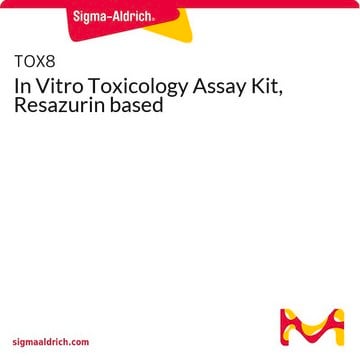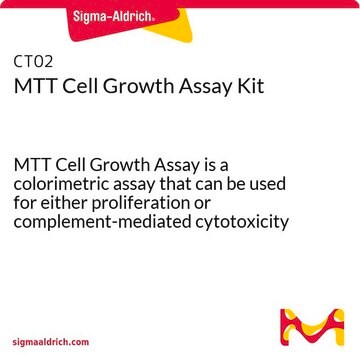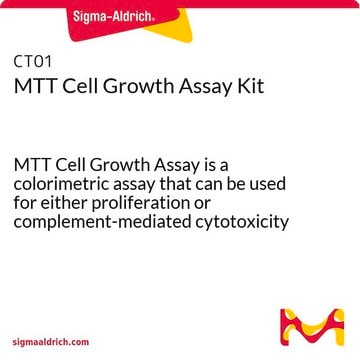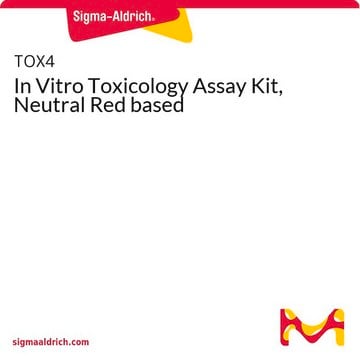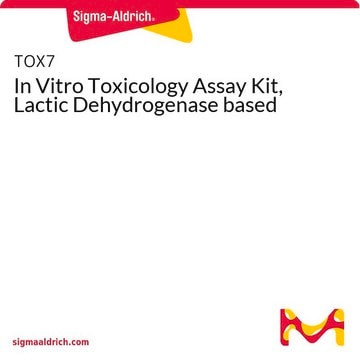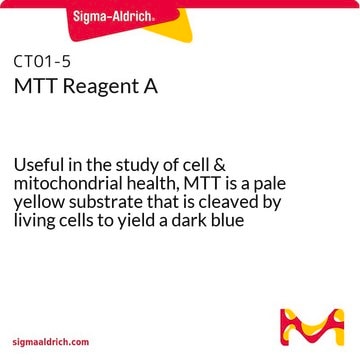The MTT asay is a method to assess cell viability. This assay is a semiquantitative assay. The assay is used to compare the viability changes in treated cells to untreated cells. The absorbance is indicative of the cell number. The higher the absorbance, the greater the number of viable cells present. Most researchers compare the absorbance of the two samples as a ratio (ABS treated cells/ABS untreated cells) to get a fold increase/decrease in cell number.
¥82,800
出荷可能日2025年4月07日詳細
おすすめの製品
使用法
1 kit sufficient for 1,000 tests
包装
pkg of 1 kit
保管条件
dry at room temperature
λmax
570 nm
アプリケーション
cell analysis
detection
検出方法
colorimetric
保管温度
2-8°C
関連するカテゴリー
詳細
アプリケーション
生物化学的/生理学的作用
シグナルワード
Danger
危険有害性の分類
Aquatic Acute 1 - Aquatic Chronic 2 - Eye Dam. 1 - Flam. Liq. 2 - Muta. 2 - Skin Corr. 1 - STOT SE 3
ターゲットの組織
Central nervous system, Respiratory system
保管分類コード
3 - Flammable liquids
引火点(°F)
53.6 °F
引火点(℃)
12 °C
適用法令
試験研究用途を考慮した関連法令を主に挙げております。化学物質以外については、一部の情報のみ提供しています。 製品を安全かつ合法的に使用することは、使用者の義務です。最新情報により修正される場合があります。WEBの反映には時間を要することがあるため、適宜SDSをご参照ください。
毒物及び劇物取締法
キットコンポーネントの情報を参照してください
PRTR
キットコンポーネントの情報を参照してください
消防法
キットコンポーネントの情報を参照してください
労働安全衛生法名称等を表示すべき危険物及び有害物
キットコンポーネントの情報を参照してください
労働安全衛生法名称等を通知すべき危険物及び有害物
キットコンポーネントの情報を参照してください
カルタヘナ法
キットコンポーネントの情報を参照してください
Jan Code
キットコンポーネントの情報を参照してください
この製品を見ている人はこちらもチェック
資料
Quality control guidelines to maintain high quality authenticated and contamination-free cell cultures. Free ECACC handbook download.
Cell based assays for cell proliferation (BrdU, MTT, WST1), cell viability and cytotoxicity experiments for applications in cancer, neuroscience and stem cell research.
-
Is the MTT assay quantitative?
1 回答-
役に立ちましたか?
-
-
What is the Department of Transportation shipping information for this product?
1 回答-
Transportation information can be found in Section 14 of the product's (M)SDS.To access the shipping information for this material, use the link on the product detail page for the product.
役に立ちましたか?
-
-
What is the difference between product CGD1, Cell Growth Determination Kit and product TOX1, In Vitro Toxicology Assay Kit?
1 回答-
Product CGD1 and TOX1 are both MTT based assays. The major difference between product CGD1 and TOX1 is that TOX1 contains 10 % Triton X-100 in the solubilization solution for better lysis of the cells and solubilization of the MTT. If there is complete cell lysis, the results obtained with both kits would be the same. The MTT in this kit is a solution, whereas the TOX1 assay kit contains the MTT as a powder that is solubilized before use.
役に立ちましたか?
-
アクティブなフィルタ
ライフサイエンス、有機合成、材料科学、クロマトグラフィー、分析など、あらゆる分野の研究に経験のあるメンバーがおります。.
製品に関するお問い合わせはこちら(テクニカルサービス)


